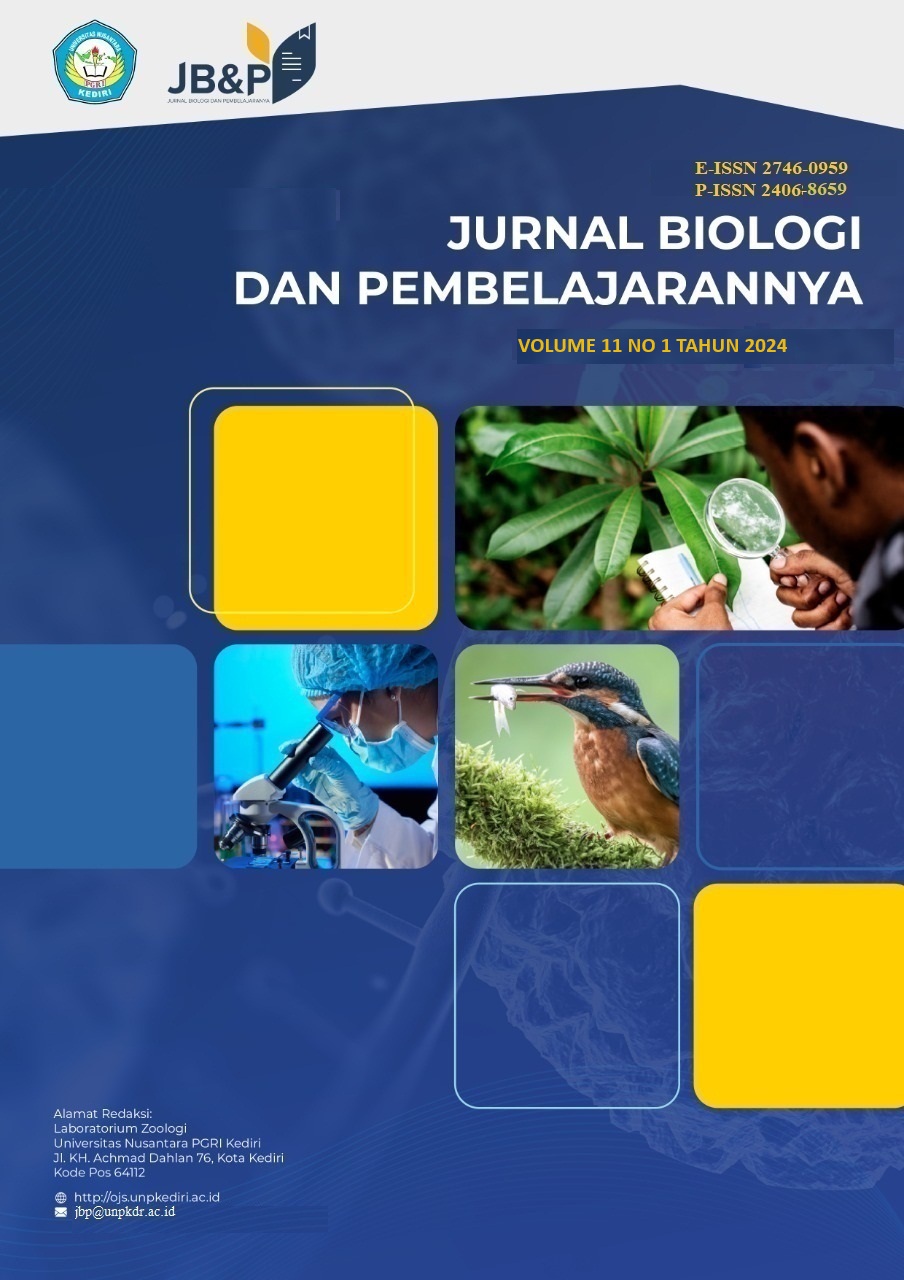Uji Aktivitas Antibakteri Dari Ekstrak Daun Sirih Terhadap Bakteri Bacillus cereus
DOI:
https://doi.org/10.29407/jbp.v11i1.21662Keywords:
Antibacterial Activity, Betel Leaves, Bacillus cereus.Abstract
This study elucidates the role of secondary metabolites in green betel leaves (Piper betle) as antibacterial agents against Bacillus cereus, a bacterium causing various foodborne illnesses in humans. The experimental research was conducted at the Biology Laboratory, Faculty of Mathematics and Natural Sciences, Universitas Negeri Medan, utilizing Bacillus cereus bacterial isolates and extracting betel leaves using water. The measurement of inhibition zones was performed to evaluate the antibacterial activity of the betel leaf extract. The research results indicate the presence of an inhibition zone against Bacillus cereus growth, albeit categorized as weak. The measurements varied across repetitions, namely 2.6 mm, 3.35 mm, and 1.05 mm. The average of these three results was 3 mm.
References
Angin, Y. P., Purwaningrum, Y., Asbur, Y., Rahayu, M. S., & Nurhayati. (2019). Utilization of secondary metabolite content produced by plants in biotic stress. Agriland : Jurnal Ilmu Pertanian, 7(1), 39–47. https://jurnal.uisu.ac.id/index.php/agriland/article/view/3471
Brooks, G.F., Butel, J. S., Carroll, K. C., Morse, S. A. Jawetz, Melnick, & Adelberg. (2007). Medical Microbiology. 24 th Ed. New York: Mc Graw Hill.
Davis, W. W., & Stout, T. R. (1971). Disc plate method of microbiological antibiotic assay: I. Factors influencing variability and error. Applied microbiology, 22(4), 659-665.
FahdiF. (2018). Uji Aktivitas Antibakteri dari Ekstrak Daun Sirih Hijau (Piper betle L.) Terhadap Bakteri Staphylococcus aureus dan Escherichia coli. Jurnal Public Community, 11(1), 47–50.
Haryuni, N., Widodo, E., & Sudjarwo, E. (2015). Aktivitas Antibakteri Jus Daun Sirih (Piper Bettle Linn) Terhadap Bakteri Patogen Dan Kualitas telur Selama Penyimpanan. TERNAK TROPIKA Journal of Tropical Animal Production, 16(1), 48–54. https://doi.org/10.21776/ub.jtapro.2015.016.01.8
Jenie, B., & T. Suhartono, M. (2012). Aktivitas antibakteri Fraksi-FRAKSI EKSTRAK Sirih Hijau (Piper Betle Linn) Terhadap Patogen pangan. Jurnal Teknologi Dan Industri Pangan, 23(2), 217–220. https://doi.org/10.6066/jtip.2012.23.2.217
Khafid, A., Wiraputra, M. D., Putra, A. C., Khoirunnisa, N., Putri, A. A. K., Suedy, S. W. A., & Nurchayati, Y. (2023). UJi Kualitatif Metabolit Sekunder pada Beberapa Tanaman yang Berkhasiat sebagai Obat Tradisional. Buletin Anatomi Dan Fisiologi, 8(1), 61–70. https://doi.org/10.14710/baf.8.1.2023.61-70
Maida, S., & Lestari, K. A. P. (2019). Aktivitas antibakteri amoksisilin terhadap bakteri gram positif dan bakteri gram negatif. Jurnal Pijar MIPA, 14(3), 189-191.
Manikome, N. (2022). Isolat bakteri Bacillus Cereus Frank. Dari Tanah Pada Beberapa Kawasan (studi Kasus Minahasa Tenggara Dan Minahasa Selatan). JUSTE (Journal of Science and Technology), 2(2), 196–206. https://doi.org/10.51135/justevol2issue2page196-206
Purwanto, U.M.S., Pasaribu F.H., & Bintang M. (2014). Isolasi Bakteri Endofit dari Tanaman Sirih Hijau (Piper betle L.) dan Potensinya sebagai Penghasil Senyawa Antibakteri. Current Biochemistry, 1 (1), 51-57.
Rahayu, C., & Salikun, S. (2020). Efektivitas rebusan Daun Sirih Merah (Piper Betle Crocatum) Dan Rebusan Daun Sirih Hijau (Piper Betle Linn) TERHADAP puberty gingivitis. Jurnal Ilmiah Keperawatan Gigi, 1(1). https://doi.org/10.37160/jikg.v1i1.503
Sheira Rait, A., Nurhasanah, N., & Abadi Kiswandono, A. (2021). ANALISIS AKTIVITAS ANTIBAKTERI EKSTRAK DAUN SIRIH HIJAU (Piper betle Linn) PADA HANDSOAP MENGGUNAKAN METODE CAKRAM. Analit:Analytical and Environmental Chemistry, 6(02), 122–133. https://doi.org/10.23960/aec.v6.i2.2021.p122-133
Suliantari, S., Jenie, B.S.L. and Suhartono, M.T. (2012). Aktivitas Antibakteri Ekstrak Sirih
Downloads
Published
Issue
Section
License
Authors who publish with this journal agree to the following terms:
- Copyright on any article is retained by the author(s).
- The author grants the journal, right of first publication with the work simultaneously licensed under a Creative Commons Attribution License that allows others to share the work with an acknowledgment of the work’s authorship and initial publication in this journal.
- Authors are able to enter into separate, additional contractual arrangements for the non-exclusive distribution of the journal’s published version of the work (e.g., post it to an institutional repository or publish it in a book), with an acknowledgment of its initial publication in this journal.
- Authors are permitted and encouraged to post their work online (e.g., in institutional repositories or on their website) prior to and during the submission process, as it can lead to productive exchanges, as well as earlier and greater citation of published work.
- The article and any associated published material is distributed under the Creative Commons Attribution-ShareAlike 4.0 International License













